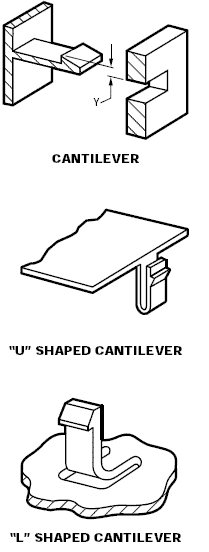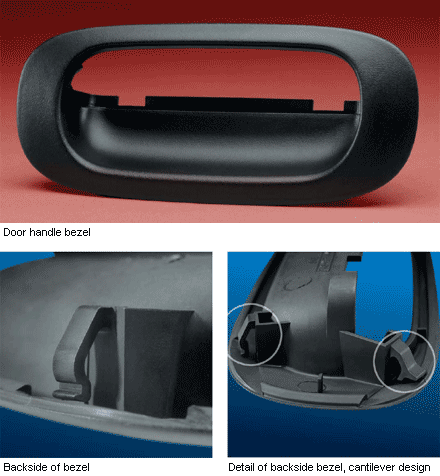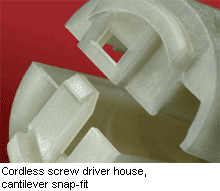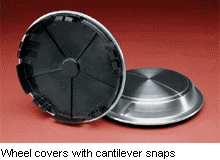Ifp Snap Fit Design Tool
Paid content by BASF
By Chul Lee, BASF
ABSTRACT: This series of articles provides a basic overview of snapfit design types and their applications, as well as traditional and improved formulas for snapfit strength and assembly force. The series also reviews common causes of snapfit failure and how to overcome them, appropriate materials and processing considerations.
Welcome to the first in a series of articles on Snapfit design presented by BASF Engineering Plastics. The intent is to help design engineers achieve better results through the use of improved principles and procedures for snapfit design, application, processing and fabrication.
Part 1 Introduction and Overview of General Applications and Types
Part 2 Principles of Classical Beam Theory and Design
Part 3 Improved Cantilever Design and Guidelines to Avoid Common Difficulties
Part 4 Materials Selection
PART I – IMPROVING SNAPFIT DESIGN: General Application and Types
Introduction
Snapfit designs are the simplest, quickest and most cost-effective method of assembling two parts. No screws. No rivets. No welds. And, after assembly, faster disassembly and servicing of components.
Thermoplastic materials possess many characteristics and features that are ideal for snapfit designs:
- High flexibility
- Integrative designs enabling the molding of complex geometries
- Relatively high elongation
- Low coefficient of friction
- Strength and rigidity sufficient for most applications.
Properly designed, thermoplastic snapfits can be assembled, disassembled and reassembled several times – without adverse effect on the functional integrity of the snapfit. If materials are prone to relax over time, snapfits can be designed to self adjust and maintain sealing capability.
From the broader perspective of sustainability, snapfit's ease of disassembly simplifies the recycling of components made from different materials, thereby encouraging more environmentally friendly behavior throughout the lifecycle of components and end products.
Still, various factors keep some snapfit designs from delivering the full benefits of their potential. BASF hopes to help overcome such obstacles through this series of articles that will provide designers a basic overview of the types of snapfit designs, applications and principles, improved methods, and guidelines for avoiding common pitfalls in snapfit design, processing and materials selection.
Most Common Types
 Most snapfit applications use one of three cantilever designs:
Most snapfit applications use one of three cantilever designs:
- Straight beam cantilever
- U-shaped cantilever
- L-shaped cantilever.
The straight beam cantilever design is broadly applicable. U- and L-shaped cantilevers, on the other hand, are specifically used in applications where space restrictions constrain beam geometry.
Cantilever structures have been around for a long time. Design engineers know them from their common use in bridges and such architectural structures as overhangs and balconies, not to mention their popularity in single-wing aircraft design. Applications for snapfit cantilever designs now range anywhere from mundane tamper-proof aspirin bottle-and-cap assemblies to highly engineered, rugged parts such as power tool housings, automotive wheel covers, air cleaner housing and door handle assemblies to name just a few.
Traditional materials for cantilever structures – such as stone and metals – are strong and rigid. Evaluation based solely on those two properties, however, overlooks important elements of cantilever design. Use of thermoplastics introduces additional concepts to the mix of criteria. To take advantage of the true strengths of thermoplastics for snapfits, designers must factor in new considerations that are the subjects of the second and third articles of this series:
"Principles of Classical Beam Theory and Design"
and "Improved Cantilever Design"
Part II will explore the traditional formulas for calculating cantilever stresses and strain. Part III will present improved formulas that provide precise calculations applicable in the use of thermoplastics.



Part 1: Introduction and Overview of General Applications and Types
Part 2: Principles of Classical Beam Theory and Design
Part 3: Improved Cantilever Design and Guidelines to Avoid Common Difficulties
Part 4: Materials Selection
About the Author
| Chul Lee, Applications Technology Leader BASF Email: chul.lee@basf.com Website: http://www.basf.com/group/corporate/en/ | Chul Lee, an Applications Technology Leader at BASF, has been involved with plastics applications and developmental activities for the past three decades. Working out of BASF Corporation's Wyandotte, Michigan facility, Chul has a wealth of experience in various areas of plastics research, including service life prediction research for the plastics pipeline industry, and application of CAE technology for plastics product development. Chul's current endeavors in the field are focused on the development of plastics joining technology, such as vibration welding, laserwelding and mechanical fastening.During the last 10 years, Chul has been actively involved in applications development work pertaining to the automotive and industrial market segments. Concentrating on application developments for the automotive powertrain market, including plastic air intake manifold developments and oil supply systems, Chul has coordinated BASF Global Research on Joining Technologies, such as vibration welding, laserwelding, snap fits, mechanical fastening and adhesive joining. Results of Mr. Lee's research is often disseminated both internally and in the public domain by virtue of participation in seminars and publication distribution at major technical conferences.Chul, a Ph.D. graduate from the University of Michigan's Mechanical Engineering department, has published many papers on various technical development topics. His academic specialization in the field of Fracture Behavior of Plastics Materials enables his astute research and subsequent publication of a multiplicity of topics, ranging from Snap Fit Design, Ribbing Design Optimization, Vibration welding optimization, and NVH (Noise Vibration and Harshness) experiments and simulations of air intake manifolds, and Laserwelding. Chul is also responsible for several patents, such as a patent on NVH, multiple patents on vibration welding, and currently has a patent pending on stone impact resistant ribbing design. |
The views, opinions and technical analyses presented here are those of the author or advertiser, and are not necessarily those of ULProspector.com or UL. The appearance of this content in the UL Prospector Knowledge Center does not constitute an endorsement by UL or its affiliates.
All content is subject to copyright and may not be reproduced without prior authorization from UL or the content author. The content has been made available for informational and educational purposes only. While the editors of this site may verify the accuracy of its content from time to time, we assume no responsibility for errors made by the author, editorial staff or any other contributor.
UL does not make any representations or warranties with respect to the accuracy, applicability, fitness or completeness of the content. UL does not warrant the performance, effectiveness or applicability of sites listed or linked to in any content.
Ifp Snap Fit Design Tool
Source: https://knowledge.ulprospector.com/1235/pe-snapfit-1/
Posted by: buenolabody.blogspot.com

0 Response to "Ifp Snap Fit Design Tool"
Post a Comment